Vetiver Handicraft Training Course Held in China
It was a dream for China Vetiver Network to organize a vetiver handicraft training course. As early as in 2002 when China Vetiver Network was implementing China Vetiver and Agroforestry Technology Project in the Dabie Mountains supported by Salvation Army, China Vetiver Network prepared to organize the training course and submitted a proposal as an additional component of the project to Salvation Army. Unfortunately, caused by the deadly car accident that caused 4 deaths and 3 seriously injured the program had to be canceled. Now the program finally came true through multiple parties joint effort.
Contents:
Final Evaluation and Award Ceremony
At the end of 2006 when a project titled Poverty Reduction and Resource Protection in a Guangxi Province Minority Area launched in Guangxi Province supported by EED of Germany, a handicraft training proposal was prepared. It was submitted to EED when Ms. Stefanie Elbern firstly visited Nanjing in June 2007. She expressed high interest and accepted the proposal for consideration. A little while she contacted Mr. Richard Grimshaw for co-sponsorship and a positive answer was received quickly from the Vetiver Network International (TVNI). The proposal was finally approved by EED in September 2007.
At same time China Vetiver Network started a series of preparations for the training course:
- A colorful brochure was prepared to introduce vetiver handicraft production and distributed to local farmers in order to let farmers know of the value of vetiver handicrafts and generate their interest in participate in the training.
- Local project partners were asked to prepare for the training a few months earlier before the starting date. This preparation included: the organization of the training course, selection of training location and trainees, preparation of handicraft materials (vetiver grass) and tools.
- A field survey was undertaken in Jiangxi Province to prepare vetiver pruning for transport to Guangxi in order to fill the gap for any shortfall of vetiver prunings at the training centre.
Since there was no previous experience of vetiver handicraft in China, the China Vetiver Network contacted the Royal Development Projects Board of Thailand to kindly assist them by sending three Thai trainers to China as early as in August 2007. When the proposal was finally approved by EED a formal request was sent to Thailand. A little later, RDPB prepared an official document for Community-based Products Quality Development Division under the Department of Industrial Promotion of the Ministry of Industry of Thailand in September 2007. In late September three Thai trainers were chosen and everything moved smoothly.
To ensure that the training is more effective and successful, a Leading Group consisting of directors of institutions and governmental bureaus from Guilin City, Longsheng County, and Sishui Township government was established. Besides, an Implementation Group from the Township Agriculture Extension Station and County Agriculture Bureau were organized. Each group has its detailed responsibilities.
The Opening Ceremony: In the afternoon 22 October 2007, the Opening Ceremony of the Vetiver Handicraft Training Course Held at the Women’s Technology School of Country Women’s Federation in Lipai Village of Sishui Township in Longshen County of Guangxi Province, it is about 10 km away from the county. In addition to leaders from Guilin City, Longsheng County, and Township governments, reporters from TV or newspapers from Guangxi Province, Guilin city, and Longsheng County attended the ceremony. All of the attendees expressed high enthusiasm in the training course thanks to the multiple international donors, domestic cooperative institutions, and Thai trainers. The governor of Sishui Township Government spoke highly of the achievement made since the initiation of the project over 10 months ago and sent his thanks to Thai trainers for their long distance travel to China to teach Chinese farmers.
The head of Thai delegate Mr. Pitaya Srijamlong was invited to reply. He expressed thanks to the China Vetiver Network for inviting his delegation to China and briefly introduced vetiver handicraft techniques in Thailand, including:
- Post-harvest treatment of vetiver leaves
- Training on how to make vetiver handicrafts
- Handicraft products after receiving training
- Animal figures made from vetiver leaves
- DIP’s 96 vetiver handicraft contest
- DIP’s 99 vetiver handicraft contest and exhibit
- The exhibitions of vetiver handicrafts products development
- Bureau of Cottage and Handicraft Industries Development.
To guarantee the training progresses more smoothly, the Thai delegate brought to China; tools; materials, and sample products. Some CDs and printed material were also given to the Chinese trainees.
The Coordinator of the China Vetiver Network, Prof. Liyu Xu, introduced the history and development of the Vetiver System in China and in the world, the multiple functions of VS for sustainable agriculture, engineering protection, and environmental protection. The Importance of the vetiver handicraft training course was emphasized in order to help farmers get direct profit and generate more interests in planting vetiver grass.
To introduce the Vetiver System more systematically and vividly, a poster exhibition was prepared and shown at the training site. It was divided into four parts: (1) General introduction of VS; (2) VS for sustainable agriculture; (3) VS for engineering and environmental protection; and (4) Bilateral visits between China and Thailand. It contained plenty of pictures most of them were taken in China and attracted many people from both nearby villages and visiting tourists.
A total of 80 persons participated in the ceremony. After the ceremony, the selected 20 trainees met to arrange details of the training course, including the location, logistics arrangement, time schedule, and regulation requested, etc. Most trainees were minority women. Few male farmers who had experience in bamboo handicraft also participated in the training course. After the initiation of the training some other farmers insisted on participating in the course, therefore the number of trainees increased to 25. The oldest was 67 years old, while the youngest, 23 years old.
Leaf Treatment:
On 23 October 2007, the trainers led the trainees to a vetiver plot where the vetiver grass was planted in April 2007. They showed the trainees how to cut the grass and what kind of grass was suitable for handicraft. They pointed out that vetiver leaves should be cut at an age of 3 months. If too young, the leaves may not be long enough for handicraft; if older than 3 months, there were many knots and the leaves would be fragile and easy to break. Vetiver grass should be cut at 12-15 cm above ground. After the grass was cut down, the trainers taught the farmers to select the leaves, separate them from stems and put them in order, wrapped in bunches. The leaves should be divided into two groups: the long leaves and the short ones. All of them could be used for handicraft. After that, the leaves were boiled in water for 3 minutes and hung out to allow water to drip. Then the leaves were spread on the floor to dry in the sun for 3 days.
Just while the farmers were waiting for dry of leaves, 10 big bags of boiled and dried leaves were transported to the training site from Experimental Station of the Chinese Academy of Sciences in Jiangxi Province. Although the grass were 6-month old and many of them had flowers and knots and not very suitable for handicraft, it was still useful for the trainees for practical purpose and saved a lot of time while waiting for the boiled leaves to dry. Furthermore, through comparison, farmers knew which leaves were good for handicraft.
Later, the trainers taught the farmers to select the dried leaves and separate them into two parts: the leaves edges and the central portion containing veins. The former could be used to make thin ropes for bag handles, while the latter are used directly for handicraft making.
The trainers also taught the farmers to dye the leaves. The selected dried leaves were soaked in water before dyeing. For different color dying, the boiling times were different.
Practicing Handicraft Making:
While the farmers were busy with leaf treatment described above, the head of the Thai Delegation, Mr. Pitaya Srijamlong, designed and made moulds with foam materials. Once the trainees got the moulds, real handicraft practice started. The first model was a small square bag. The trainers introduced the general method and then hands-on teaching to individual farmers. Since there were few old male farmers who had experience in bamboo handicraft, they learned much faster than the others and acted as assistants of the trainers. In addition, they helped to find local materials (bamboo) as supplemental materials (skeleton) for handicrafts. However, a few days later the young minority women grasped the basic method and practiced much better than old men.
For most of the trainees, the first product of a small bag was finished in just two days. Then farmers started to learn making different products: multiple containers, hats, baskets, mats, etc. based on different moulds made by Mr. Pitaya. Meanwhile, Mr. Bi Weijun from the Township Agriculture Technology Extension Station who was responsible for the project implementation and Mr. Qing Wushen started to learn to make different moulds with foam. As a result, the trainees could learn to make more different kinds of handicrafts. At the end of the training course almost all of the trainees could produce at least 3 different products. Most of them could design and create new products based on their own use and local markets.
Short Meetings for Problem-solving:
Every 3-4 days, there was a short meeting held in the afternoon before finishing one-day’s work, aimed at problem solving to improve the training process.
Skill Improvement:
To improve the technology, the trainers asked the trainees to compare their products and pointed out the good points and shortcoming of typical examples so that trainees could understand which is good and which is bad, and why. Through this comparison the skill of the trainees improved very quickly.
Additionally, all products were exhibited in order to let the people compare the work and encourage the trainees to take part in the competition. On the second day of training, a few of the farmers took their un-finished product home to continue their work in the evening. Later, almost all of the farmers continued their production at home, which saved a lot of time and enhanced work efficiency.
Materials for Moulds:
As this was the first vetiver handicraft training course, there were some problems to be solved. First of all there was a shortage of moulds. To let farmers learn to produce more different products, multiple moulds should be made. However, in the mountain county it was not easy to find foam, even the used foam. Therefore trainees were asked to search for used foam. But still little foam was found. Latter administrators found several big used-foam boxes at the county free market and solved the problem.
Fire Prevention:
Another problem was fire prevention. This is a very important issue because local buildings were all made from wood. In case of fire the consequences could be terrible and the training would fail. In the first few days all trainees were busy with treating vetiver leaves and it was not a big problem. However, later when farmers started to practice handicrafts, more and more remnants and litter were left on the ground everywhere that was easy to burn and subject to catching fire, especially when the climate was dry without rain for many days.
Unfortunately farmers were all fond of handicraft production and nobody paid attention to fire prevention. As a result the Leading Group organized a meeting to emphasize this dangerous issue and requested all trainees to pay attention. The group leaders instructed all trainees to clean up the workshop and store water for fire prevention at the training site. The township government hung Caution Boards at conspicuous sites. In addition, all the trainees were divided into several small groups responsible to take it in turns to clean up the workshop after work each day.
At same time, the dry leaves were used as fuel to boil water during dying in order to reduce dangerous materials at the training site.
Final Evaluation and Award Ceremony
On 3 November, an Evaluation Committee was proposed consisting of the 3 Thai trainers, 1 from Township Government, 2 from County Agriculture Bureau, 2 from China Vetiver Network, and 1 from local farmers. Moreover, a guideline for final evaluation and awarding was prepared by China Vetiver Network. The parameters considered for awards selection were:
- Material selection: including the color, thinness and length of the leaves, the treatment of the leaves;
- Manufacturing skills: the transition of different parts of a whole product should be done smoothly, without a break, joint or void.
- Decoration: design, the patterns, small decoration material, etc.
- Formative level: the whole product should be beautiful as a work of art.
- Complexity: If the product was easy or difficult to make.
Choosing of the Awards:
On 3 November, 40 products were exhibited, of which 21 were selected for evaluation. On 4 November, 10 products were further selected for final evaluation. In early afternoon of 4 November the result of selection was completed:
Altogether there were 6 awardees of which 5 were women.
- 1st Prize (one person, 200 Yuan): Ms. Wu Songlian.
- 2nd Prize (two persons, 100 Yuan each): Ms. Zhong Bizhen and Ms. Hou Shizhen.
- 3rd Prize (3 persons, 50 Yuan each): Ms. Hou Lianfen, Mr. Shi Xianzhou, and Ms. Shi Lingyan.
In addition to prize money, all of the above successful candidates got a set of photos showing different vetiver handicraft produced in Thailand, that was sent by trainers and reproduced by Guilin partner. These will be very useful for them to design and produce new handicrafts.
As a consolation prize, one towel and a bag of washing powder was given to the other trainees who did not get awards.
The Closing Ceremony:
The closing ceremony stared at 2 p.m. on 4 November. Leaders from institutions and governmental bureaus of Guilin City, Longsheng County, and Sishui Township attended. They expressed sincere thanks to the three trainers and donors. They pointed out that the training course strengthened the friendship between China and Thailand. Emphasis was given to vetiver grass planting for soil conservation. They encouraged the farmers to plant more vetiver for sustainable farming.
Prof. Wang Haoqing of China Vetiver Network presented a keynote speech. He pointed out that the handicrafts could generate direct profit for farmers at the same time promoting further vetiver applications for soil erosion control. Many thanks should be given to the organizers from the multiple institutions.
After the speeches, the Chairman announced the selection process and the resulting awards He then presented the awards.
Afterward, multiple photos were taken to remember the very happy occasion. Then a party started. A local person sang a song composed by herself to at 4 p.m.
To express their sincere thanks, the organizers arranged a tour for the trainers in the famous beautiful Guilin City.
The Most Successful Training Course:
Everybody felt that the training was the best one and the most successful. At the beginning of the training course, an organization was established that consisted of many important people from multiple cooperation parties. Each person of the Leading Group had its detailed responsibility. Everything was planned and arranged very clearly and implemented smoothly. Around 10 key persons from various institutions were actively involved in the organization and in-course service, of which 4 scientists from China Vetiver Network worked at the training site.
Both trainers and trainees all worked very hard. Trainees learnt very earnestly, while trainers taught very patiently. Besides, logistics people did a very good job to guarantee the implementation efficiently. Our guests - the three trainers were very happy with the logistics arrangement.
In addition, the trainers brought China many necessary tools that might be difficult to find in China in a short time and enabled the training course to implement successfully.
All these inputs made the training most successful. All of the cooperating parties and persons were satisfied with the training course.
The successful training course indicated that to invite Thai trainers to China to teach local farmers is more economical than sending very few farmers abroad to learn.
Impact of the Training Course:
The training course had a great impact on the local people. During the training, reporters from TV and the newspaper visited and interviewed different people, and many of the public visited and took photos.
The directors of Heping Township Government led a delegation to visit the training and expressed high interests in vetiver grass and vetiver handicrafts and hope to organize training course in their town.
Farmers in Dabie Mountains also hope to have a training course in their place in order to extend the technology in the mountains that has a large area for about 100,000 km2.
Follow Up Activities and Further Consideration:
Although the training course lasted over two weeks, it is not enough for minority farmers to grasp the full technology. As a result almost all of the people hoped that the 2nd and 3rd training course could be organized in the near future.
However, due to the limited time some processes could not be taught during the training, for example the sulfur-fumigated process. The trainees should practice these themselves. Besides, some problems remained to be solved after the course.
Materials and Tools:
All of the training process was done according to Thai background, for example the climate, the custom, and the materials. We should find the best time for cutting grass based on the local climate, and should find local materials as supplementary material, in addition to tools, dye chemicals, paint etc. In addition moulds should made from wood for long time use.
Marketing: It is considered that the vetiver handicrafts marketing can be divided into several steps:
- Handcrafts for farmers’ family use;
- Handcrafts for roadside -market in their own village;
- Handicrafts for a nearby tourism plot Hot Spring, which is 15km away;
- Handicrafts for Guilin tourism market.
Following these steps, the skill should be improved and new products should be designed.
To help farmers open their market, there should be organizers or business agents involved from the local village or township. Such people were tentatively proposed during the course.
In addition, it is expected that the existing handicraft plants in Guangxi Province can use vetiver grass and bring vetiver handicrafts into their present market; while trainees could have the opportunity to learn handicraft in their premises.
Second Vetiver Handicraft Training Course:
All people involved hope to organize the 2nd training course in China. During the course the awarded trainees will now be trainer assistant in order to train more people and to improve their skill. In addition, a local training course is needed to get more people involved and to extend the skill to the whole Guangxi Province.
Training Course in the Dabie Mountains:
Dabie Mountain is a large area that has serious erosion problems. There is a great need to organize the course to help farmers there to produce handicraft to increase profit. At the same time erosion can be better controlled.
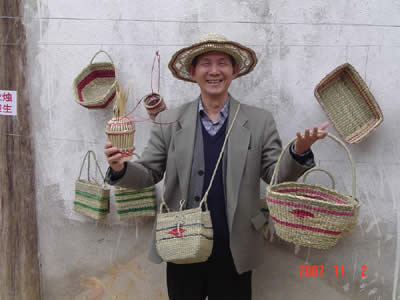
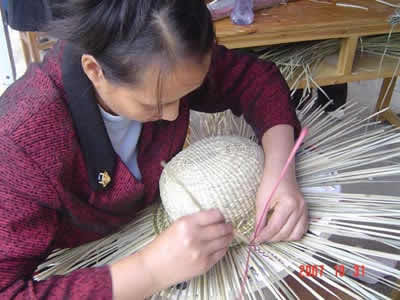
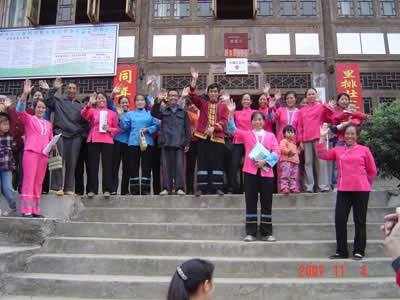
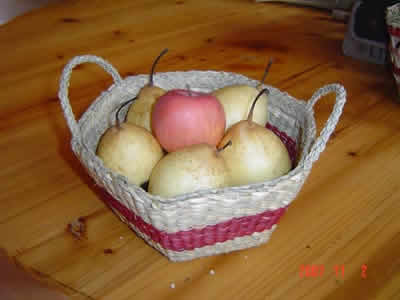
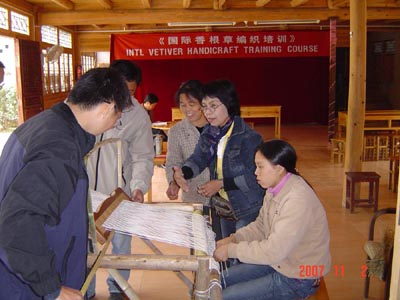
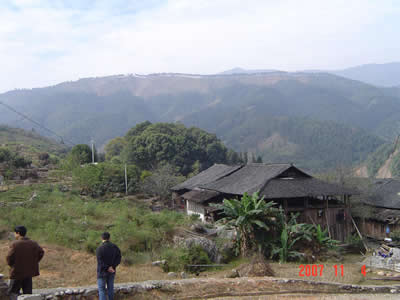
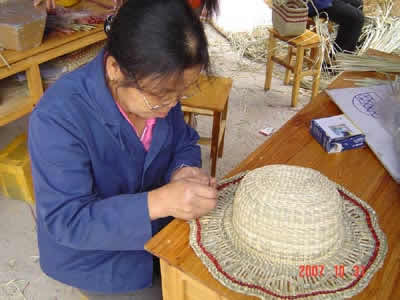
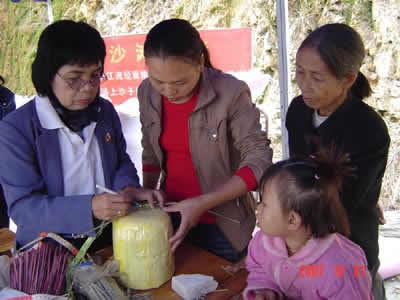
Published January 12, 2008